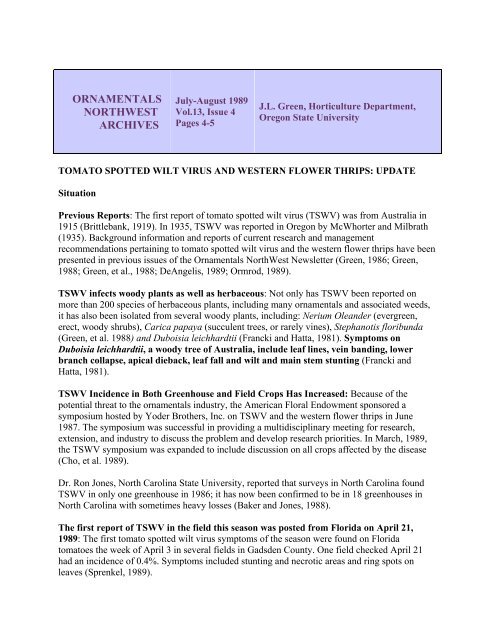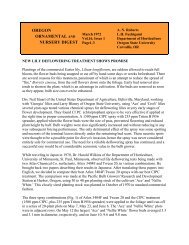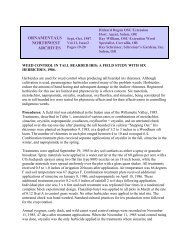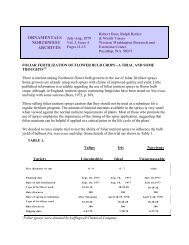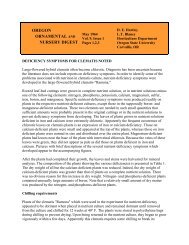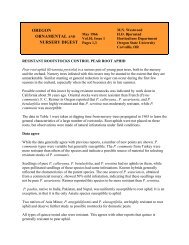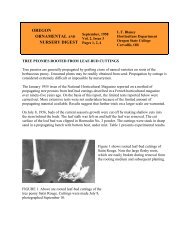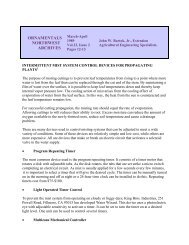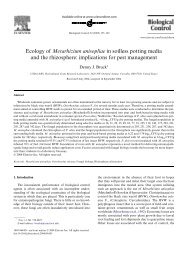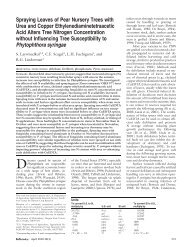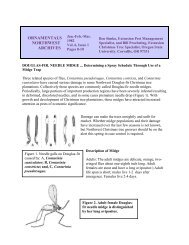Tomato Spotted Wilt virus and Western Flower Thrips: Update, Vol ...
Tomato Spotted Wilt virus and Western Flower Thrips: Update, Vol ...
Tomato Spotted Wilt virus and Western Flower Thrips: Update, Vol ...
Create successful ePaper yourself
Turn your PDF publications into a flip-book with our unique Google optimized e-Paper software.
ORNAMENTALSNORTHWESTARCHIVESJuly-August 1989<strong>Vol</strong>.13, Issue 4Pages 4-5J.L. Green, Horticulture Department,Oregon State UniversityTOMATO SPOTTED WILT VIRUS AND WESTERN FLOWER THRIPS: UPDATESituationPrevious Reports: The first report of tomato spotted wilt <strong>virus</strong> (TSWV) was from Australia in1915 (Brittlebank, 1919). In 1935, TSWV was reported in Oregon by McWhorter <strong>and</strong> Milbrath(1935). Background information <strong>and</strong> reports of current research <strong>and</strong> managementrecommendations pertaining to tomato spotted wilt <strong>virus</strong> <strong>and</strong> the western flower thrips have beenpresented in previous issues of the Ornamentals NorthWest Newsletter (Green, 1986; Green,1988; Green, et al., 1988; DeAngelis, 1989; Ormrod, 1989).TSWV infects woody plants as well as herbaceous: Not only has TSWV been reported onmore than 200 species of herbaceous plants, including many ornamentals <strong>and</strong> associated weeds,it has also been isolated from several woody plants, including: Nerium Ole<strong>and</strong>er (evergreen,erect, woody shrubs), Carica papaya (succulent trees, or rarely vines), Stephanotis floribunda(Green, et al. 1988) <strong>and</strong> Duboisia leichhardtii (Francki <strong>and</strong> Hatta, 1981). Symptoms onDuboisia leichhardtii, a woody tree of Australia, include leaf lines, vein b<strong>and</strong>ing, lowerbranch collapse, apical dieback, leaf fall <strong>and</strong> wilt <strong>and</strong> main stem stunting (Francki <strong>and</strong>Hatta, 1981).TSWV Incidence in Both Greenhouse <strong>and</strong> Field Crops Has Increased: Because of thepotential threat to the ornamentals industry, the American Floral Endowment sponsored asymposium hosted by Yoder Brothers, Inc. on TSWV <strong>and</strong> the western flower thrips in June1987. The symposium was successful in providing a multidisciplinary meeting for research,extension, <strong>and</strong> industry to discuss the problem <strong>and</strong> develop research priorities. In March, 1989,the TSWV symposium was exp<strong>and</strong>ed to include discussion on all crops affected by the disease(Cho, et al. 1989).Dr. Ron Jones, North Carolina State University, reported that surveys in North Carolina foundTSWV in only one greenhouse in 1986; it has now been confirmed to be in 18 greenhouses inNorth Carolina with sometimes heavy losses (Baker <strong>and</strong> Jones, 1988).The first report of TSWV in the field this season was posted from Florida on April 21,1989: The first tomato spotted wilt <strong>virus</strong> symptoms of the season were found on Floridatomatoes the week of April 3 in several fields in Gadsden County. One field checked April 21had an incidence of 0.4%. Symptoms included stunting <strong>and</strong> necrotic areas <strong>and</strong> ring spots onleaves (Sprenkel, 1989).
TSWV frequently causes 50-90% crop losses in lettuce during any season of the year in Hawaii.TSWV has become a limiting factor in lettuce production in Hawaii, especially when fields arereplanted before all the thrips that have pupated in the soil after acquiring TSWV from theprevious crop have emerged. In field experiments in Hawaii, thrips continued to emerge from thesoil for 2-3 weeks after crop residues were plowed <strong>and</strong> rototilled. More than a million thrips perhectare of crop emerged during this period (Cho, et al. 1989). Heavy damage to the young plantscan occur: Initial symptoms on lettuce are small brown necrotic spots on young leaves followedby meristem stunting, systemic wilting of the entire plant, <strong>and</strong> premature death within 2 weeksafter appearance of the initial symptoms. Today, major losses on Maui in lettuce, tomato, <strong>and</strong>pepper have forced several growers to not plant TSWV-susceptible crops (Cho, et al. 1989)Management Strategies• Genetic Resistance to TSWVHost resistance to TSWV offers the best long-term solution, but development of suitablecultivars requires several years of research.Researchers in Hawaii (Cho, et al. 1989) have screened 609 lettuce lines, mostly Lactuca sativa<strong>and</strong> Lactuca serriola L. In further evaluations, an additional 223 lines of wild <strong>and</strong> cultivatedlettuce were screened. Several L. sativa lines appeared to be resistant. Progeny tests indicatedthat none of the L. sativa lines were homozygous resistant. Results of test crosses <strong>and</strong> TSWVresistancetests of the Fl <strong>and</strong> F2 plants suggested that two cultivars ('Tinto' <strong>and</strong> 'Ancora', lines ofLactuca sativa) had the same genes for resistance <strong>and</strong> that this resistance is partially dominant(O'Malley <strong>and</strong> Hartmann, 1989).At present, several tomato lines highly resistant to TSWV <strong>and</strong> with reasonable fruit size havebeen selected; commercially suitable cultivars should become available within 2-3 years (Cho, etal. 1989).• Insecticides:26 insecticides were evaluated for control of the <strong>Western</strong> <strong>Flower</strong> <strong>Thrips</strong> (WFT) -the insecticidesdid not kill rapidly enough to prevent <strong>virus</strong> transmission; none of the insecticide treatmentssuppressed TSWV disease occurrence(Cho, et al. 1989). Dr. Ron Mau, University of Hawaii stated that, "Pesticides alone could notcontrol the <strong>virus</strong>. Even at 200 gallons per acre twice a week, there was not enough effect towarrant reliance solely on pesticide treatment" (Baker <strong>and</strong> Jones, 1988).• Cultural Practices:It is essential that all propagative plant material be free of tomato spotted wilt <strong>virus</strong>. In addition,exclusion of thrips, a program of thrips eradication, <strong>and</strong> removing infected plants are essential tohold losses to an acceptable level (Baker <strong>and</strong> Jones, 1988).
Cho, et al (1989) reached the following conclusions:1. Don't Grow TSWV-Susceptible Crops in High Incidence Areas: Management is not totallyeffective if <strong>virus</strong> <strong>and</strong> vector occurrence is high throughout the area; in this situation, TSWVsusceptiblecrops should not be planted.2. Areawide Cooperation Is Essential: Because of substantial movement of thrips betweencrops <strong>and</strong> farms, areawide cooperation is essential. Alternate hosts of the <strong>virus</strong> <strong>and</strong> thrips mustbe controlled, sequential planting of susceptible crops avoided, <strong>virus</strong>-free plants planted, <strong>and</strong>harvested or ab<strong>and</strong>oned crops immediately plowed.3. Crop isolation reduces TSWV incidence: Separate blocks of susceptible crops with blocksof nonsusceptible crops.References:Baker, James R <strong>and</strong> Ronald K. Jones. 1988. Sixth Ornamental Workshop, October 1988. NorthCarolina <strong>Flower</strong> Growers Bulletin 33(6):1-4, December 1988.Baker, James R <strong>and</strong> Ronald K. Jones. 1988a. <strong>Update</strong> on tomato spotted wilt <strong>virus</strong> <strong>and</strong> westernflower thrips. Ornamentals Northwest Newsletter 12(3):12-14.Brittlebank, C.C. 1919. <strong>Tomato</strong> Diseases. J. Agric. Victoria 17:231-235.Cho, JJ., R.F.L. Mau, T.L. German, RW. Hartmann, L.S. Yudin, D. Gonsalves <strong>and</strong> RProvvidenti. 1989. A multidisciplinary approach to management of tomato spotted wilt <strong>virus</strong>in Hawaii. Plant Disease 73(5):375-383.DeAngelis, Jack. 1989. Greenhouse management of western flower thrips <strong>and</strong> tomato spottedwilt <strong>virus</strong>. Ornamentals Northwest Newsletter 12(6):7-11.Francki, R.I.B. <strong>and</strong> T. Hatta. 1981. <strong>Tomato</strong> spotted wilt <strong>virus</strong>, Chapter 17, pp 492-511. In:H<strong>and</strong>book of Plant Virus Infections <strong>and</strong> Comparative Diagnosis, edited by E. Kurstak.Elsevier/North-Holl<strong>and</strong> Biomedical Press, 943 pp.Green, J.L. 1986. <strong>Tomato</strong> spotted wilt <strong>virus</strong> transmitted by western flower thrips. OrnamentalsNorthwest Newsletter 10(2):8-9.Green, J.L. 1988. <strong>Tomato</strong> spotted wilt <strong>virus</strong> in greenhouse crops. Ornamentals NorthwestNewsletter 12(3):10.Green, J.L., T.C. Allen <strong>and</strong> S. Fischer. 1988. Symptoms of stephanotis infected with tomatospotted wilt <strong>virus</strong>. Ornamentals Northwest Newsletter 12(3):10-11.McWhorter, F.P. <strong>and</strong> J.A. Milbrath. 1935. The interpretation of Oregon tip blight on a basis ofcausal <strong>virus</strong>es. Phytopath. 20:897-898.O'Malley, P.J. <strong>and</strong> RW. Hartmann. 1989. Resistance to tomato spotted wilt <strong>virus</strong> in lettuce.HortScience 24(2):360-362.Ormrod, DJ. 1989. Plant diagnostic clinic, BC Ministry of Agriculture & Fisheries. OrnamentalsNorthwest Newsletter 13(3):8.Sprenkel, RK. 1989. First TSWV report of season in Florida - posted April 21, 1989. NationalAgricultural Pest Information System, NAPIS.
Pesticide Use - Due to constantly changing laws <strong>and</strong> regulations, no liability for the suggested use of chemicals inthis Newsletter is assumed by the ONW Newsletter. Pesticides should be applied according to label directions on thepesticide container.Permission to Reprint material appearing in the ONW Newsletter is granted with the request that you credit thesource: Ornamentals Northwest Newsletter, date, volume, issue, page numbers. Do not excerpt or reprint in such amanner as to imply the author's endorsement or criticism of a product or concept.Nondiscrimination - The information in the Ornamentals Northwest Newsletter is provided with the underst<strong>and</strong>ingthat no discrimination is intended <strong>and</strong> that listing of commercial products implies no endorsement by the authors.Criticism of products or equipment is neither intended nor implied.


